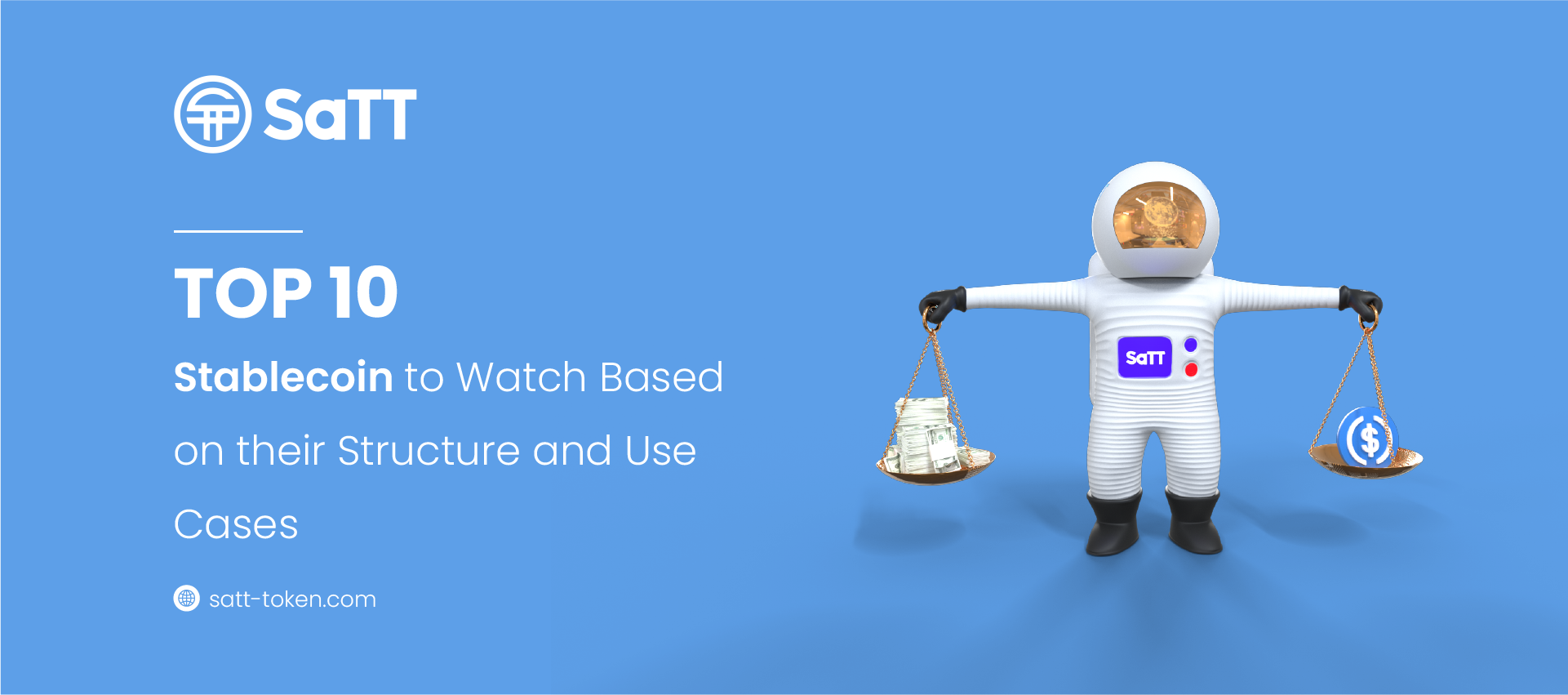
Top 10 Stablecoins to Watch Based on their Structure and Use Cases
Cryptocurrency has experienced massive growth since its emergence over a decade ago. The growth, however, is largely attributed to speculation, which comes from its notorious volatility feature. Cryptocurrency has been extremely volatile, and this has limited its use in the mainstream financial systems. For instance, 1 Bitcoin was priced at $30,000 in July this year, but the world’s #1 cryptocurrency has more than doubled in market price in just under four months. This volatility is not specific to Bitcoin, but even other cryptocurrencies have experienced the same trend over the years. For some reason, the price of Bitcoin, which is the world’s de facto reserve cryptocurrency, seems to strongly influence the price of other cryptocurrencies in the market.
While this volatility is a positive thing for investors looking to make profits, those caught on the wrong side of the rapid crypto price movements have always experienced significant losses. Additionally, the inability to rely on cryptocurrency as a medium of exchange has limited its adoption in real economic systems. This is where stablecoins come in to help those who would want to enjoy the benefits of cryptocurrency while avoiding the extreme volatility of the mainstream crypto assets such as BTC, ETH, DOGE, XRP, BCH, BNB, etc.
Before we dive into the list of top 10 stablecoins in the market today, let’s first understand what stablecoins are, the types of stablecoins, and how they work.
What Is a Stablecoin?
A stablecoin is a cryptocurrency with low volatility, adopting the stability of other stable assets, including fiat currencies, commodities, other cryptocurrencies, or algorithms. To understand how each of these stablecoins work, let’s define them according to what asset backs them.
- Fiat currency-backed stablecoins: These are stablecoins backed by fiat currencies such as US dollar reserve uses the latter as collateral. The reserve for the currency is audited regularly to maintain compliance.
- Commodity-backed stablecoins: These are stablecoins backed by hard assets such as gold or real estate. Although gold dominate the list of commodities used, some stablecoin protocols use diversified baskets of precious metals to stabilize their stablecoin assets.
- Crypto-backed stablecoins: These are stablecoins backed by other established cryptocurrencies. To counter the relatively high volatility of backing stablecoins through crypto, the coin will maintain an overcollateralized position. That is, the stablecoin will ensure the circulation of a much lower supply against the reserve as compared to the fiat-backed currencies. For instance, the stablecoin may decide to issue $1,000 worth of coins for every $400 of crypto in reserves rather than adopting the common one-to-one ratio.
- Algorithm-backed stablecoin: These stablecoins are backed by processes rather than another asset or currency. They use smart contracts to serve as the intermediary between the backing asset and the stablecoin.
A stablecoin whose value is pegged on a specific fiat currency, such as USD, or commodities such as gold, or other cryptocurrencies reliably holds the value of the backing asset over time. This makes it easy to transfer the value to the recipient if you send or spend it. For example, when you hold Bitcoin, you can easily convert it without losing much value. You can then change it into USD for ease of withdrawal into your bank account or use it to purchase goods and services.
Cryptocurrency is a free market, which has enabled developers to compete in creating stablecoins for varied functions to fulfill the needs of the target users. In this article, we are going to discuss the functionalities and utilities of the top 10 stablecoins, according to CoinMarketCap.
The top 10 stablecoins in the crypto market:
| Cryptocurrency | Market Cap | Volume traded (24h) | Circulation Supply |
| Tether (USDT) | $73,841,457,299 | $53,497,992,337 | 73,859,886,039 USDT |
| USD Coin (USDC) | $34,387,573,142 | $3,234,983,957 | 34,424,351,584 USDC |
| Binance USD (BUSD) | $12,683,991,904 | $4,685,240,554 | 12,694,721,882 BUSD |
| Dai (DAI) | $6,468,389,649 | $423,024,268 | 6,474,951,714 DAI |
| TerraUSD (UST) | $$4,997,196,224 | $55,398,678 | 4,990,974,918 UST |
| TrueUSD (TUSD) | $1,221,937,679 | $120,714,690 | 1,222,116,825 TUSD |
| Pax Dollar | $945,168,034 | $6,467,068 | 945,642,940 USDP |
| Neutrino USD | $558,606,943 | $47,220,869 | 13,159,998,943 RSR |
| Reserve Rights (RSR) | $557.146,174 | $7,702,344 | 569,370,101 USDN |
| Fei USD (FEI) | $423,743,400 | $32,119,107 | 424,996,178 FEI |
- Tether (USDT)
Tether is the largest and the most popular stablecoin. Originally launched as RealCoin in 2014, Tether derives its name from the fact that it “tethers” itself to the value of the USD, hence its supply is only limited by claimed dollar reserves.
Tether is considered one of the most secure stablecoin, and can easily integrate with fiat platforms, hence making it easy to convert to fiat, hence it’s mostly used as a trade currency.
- USD Coin (USDC)
Launched in 2018 by Coinbase crypto exchange, USDC is another popular stablecoin with a great reputation within the crypto community. The stablecoin is backed by the US dollar, and often prides itself as highly regulated and transparent. To prove this, USDC regularly publishes its statements showing its cash reserves. Coinbase claims that they have achieved regulatory compliance, hence the reason most major exchanges accept it. USDC is mainly used by decentralized applications such as decentralized finance (DeFi) and gaming platforms.
- Binance USD (BUSD)
BUSD comes at #3 among the most popular stablecoins. Founded in 2019, BUSD is also backed by the US dollar reserve. The stablecoin’s value is pegged 1:1 to the US dollar. Binance, one of the biggest crypto exchanges, is a founding member of BUSD. The implication is that users converting fiat/crypto to BUSD on Binance can do so at zero fees. BUSD has been approved by the New York State of Financial Services.
BUSD is commonly used by DeFi enthusiasts who can earn extra coins by avoiding the exchange fees. Holders of BUSD also enjoy high staking rewards on the Binance Exchange.
- Dai (DAI)
DAI is a popular stablecoin whose supply is limited by the collateral stored in its vaults. The stablecoin was founded in 2017. DAI is the first stablecoin in this list that has not been backed by fiat currency. Instead, it’s backed by other cryptocurrencies in its vaults.
DAI is one of the stablecoins that have fueled the rapid growth of DeFi, and most DApps enthusiasts consider it the best because of its algorithmic and decentralized features. These features help allay the fear of the possibility of one company having a monopoly over the stablecoin market.
It’s governed by the autonomous MakerDAO, which issues the Dai tokens. Users can mint DAI by simply depositing their ETH as collateral. DAI can be used for trade, as well as for purchasing services from DeFi protocols.
- TerraUSD (UST)
Launched in 2020, UST has one of the most interesting ways of maintaining its peg of 1:1 to US dollar. It algorithmically changes its supply based on the price and supply of Terra’s native LUNA token. This approach keeps it at an equilibrium, which maintains its value to avoid volatility.
UST focuses on scalability within the DeFi sector. In other words, UST is used to purchase DeFi services. For example, the Anchor Protocol allows users to deposit UST to earn passive rewards or yields. The stablecoin has also been a regular feature within the larger DApp space as it helps platforms mint fungible tokens and track physical assets to use it to the benchmark price. UST can also be used to trade and pay for goods and services on platforms that accept crypto payment.
- TrueUSD (TUSD)
TUSD is another stablecoin backed by the US dollar, and founders claim it’s subjected to regular audits. Launched in 2018, TUSD has its supply limited by the dollar supply under their network.
TUSD is mainly used to purchase DeFi products or fund DApps. You can also stake it to earn interest in your holdings. The stablecoin is currently partnering with a bank to make digital payments easy.
- Pax Dollar (USDP)
USDP is a US dollar-backed stablecoin that is regulated and redeemable one-to-one for the US dollar. The stablecoin is held 100% in cash and cash equivalent. Originally Paxos Standard until August this year, the stablecoin has changed its name to Pax Dollar to make it resonate with the people’s idea of a stablecoin being backed by the US dollar. USDP has 100% of its reserves held in cash and cash equivalent.
USDP was built to facilitate swift transfers of money just like other crypto assets. As a stablecoin that acts as a digital dollar, every USDP can be purchased and redeemed on Paxos.com, the parent company. In other words, USDP is not only a digital dollar currency but is also an electronic means of transacting and storing value.
- Neutrino (USDN)
USDN is an algorithmic crypto-collateralized stablecoin pegged to the US dollar. Operations involving USDN, which may include the issuance of the stablecoin, collateralization, staking, and reward payouts, are transparent. Neutrino Protocol allows users to create unique interest-bearing stablecoins with the help of its stablecoin, USDN.
Powered by a smart contract, Neutrino USD is collateralized by Waves tokens, which allow holders to earn rewards in terms of yields of between 8% and 15% APR when staked.
- Reserve Rights (RSR)
RSR is a stablecoin by the dual-token platform, Reserve Rights. Launched in May 2019, RSR is backed by other crypto-assets managed by the platform’s smart contracts. The second token under Reserve Rights is the Reserve Stablecoin (RSV), which is used to keep the RSV STABLE at its $1.00 price target through a system of arbitrage opportunities. The difference between RSV and RSR is that the latter is volatile, and it’s mainly used to maintain the stability of RSV.
Holders of RSR are also legible to vote on the protocol’s governance proposals, hence ensuring they be part of the decision-making organ on the Reserve Rights protocol’s ecosystem. Coin holders can also buy RSV at a discounted value and then sell-swap them for RSR via smart contract at a 1:1 exchange rate.
The platform aims to increase assets to back the stablecoin, and progressively move away from the US dollar peg.
- Fei USD (FEI)
FEI closes our list of the top 10 stablecoins to check out for investment purposes. The stablecoin is an algorithmic stablecoin for DeFi meant to propose a technological solution in a sweet spot between rigid overcollateralized traditional stablecoin and unpredictable but centralized existing algorithmic stablecoins. The dual-coin protocol operates with its two cryptocurrencies: FEI stablecoin and TRIBE governance token.
FEI is based on a unique kind of stablecoin mechanism known as direct incentives that aim for better capital efficiency. It also features one of the fairest distribution mechanisms and is fully decentralized. It maintains liquidity in secondary markets via the value under its control.
FEI is used to balance stablecoin peg price and protect collateral from price shocks. As a two-coin algorithmic stablecoin, it maintains the peg as its counterpart, TRIBE, is used to absorb the volatility.
Conclusion
The growth of cryptocurrency and various innovations surrounding it does not seem to stop anytime soon as we are yet to witness the full potential of the digital currency space. However, stablecoins are already positioned to be part of the growth as they aim to stabilize the extremely volatile industry to make them viably applicable in the traditional economic environment. The main role of stablecoins is to clear the regulatory hurdles to give crypto enthusiasts assurance that their assets are usable and stable to transact within the real economy.
Stablecoins continue to help realize the dream of cryptocurrencies being used in the exchange of goods and services. The ability to trade cryptocurrency 24/7 is the reason why stablecoins give traders the incentive to cash out their received digital assets without worrying about price fluctuation. Stablecoins have also enabled money to be moved faster between crypto exchanges without delay. Investors, too, can hold a part of their crypto portfolio just like cash, in a way that allows them to purchase any coin instantly without relying on unreliable bank servers.
Currently, the most dominant stablecoins are the physical asset-backed currencies. However, from the list, it’s evident that algorithmic stablecoins, led by DAI and UST, are gaining ground and becoming popular every day. The growth of algorithmic stablecoins is a good sign of a positive trend as they provide greater flexibility and rewards for holders, especially when interacting with the rapidly growing DeFi protocols.





